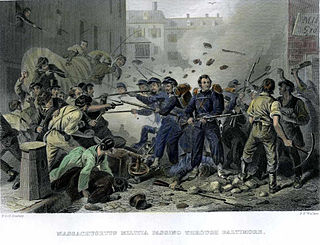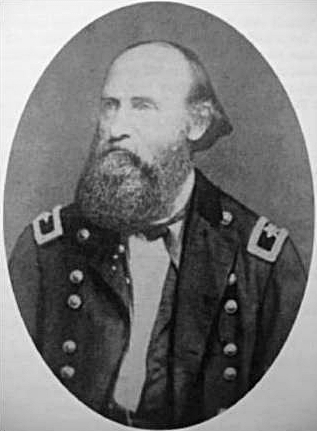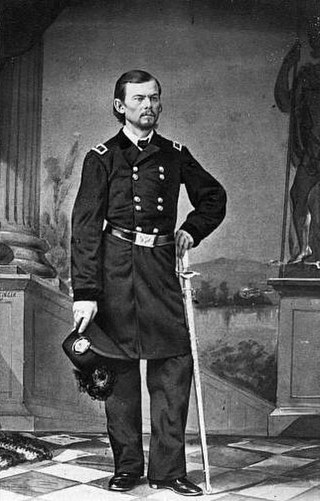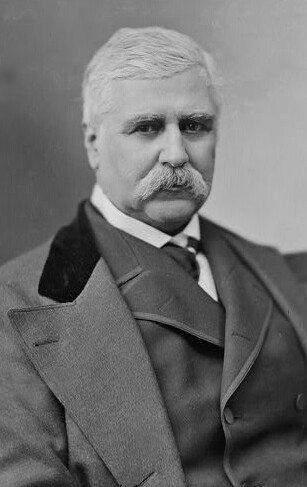
The Forty-Eighters were Europeans who participated in or supported the Revolutions of 1848 that swept Europe. In the German Confederation, the Forty-Eighters favoured unification of Germany, a more democratic government, and guarantees of human rights. Disappointed at the failure of the revolution to bring about the reform of the system of government in Germany or the Austrian Empire and sometimes on the government's wanted list because of their involvement in the revolution, they gave up their old lives to try again abroad, emigrating to Australia, the United Kingdom, and the United States. These included Germans, Czechs, Hungarians, and others. A large number were respected, politically active, wealthy, and well-educated, and found success in their new countries.

Lot Myrick Morrill was an American statesman and politician who served as the 28th Governor of Maine, as a United States Senator, and as U.S. Secretary of the Treasury under President Ulysses S. Grant. An advocate for hard currency rather than paper money, Morrill was popularly received as Treasury Secretary by the American press and Wall Street. He was known for financial and political integrity, and was said to be focused on serving the public good rather than party interests. Morrill was President Grant's fourth and last Secretary of the Treasury.

The Baltimore riot of 1861 was a civil conflict on Friday, April 19, 1861, on Pratt Street, in Baltimore, Maryland. It occurred between antiwar "Copperhead" Democrats and other Southern/Confederate sympathizers on one side, and on the other, members of Massachusetts and Pennsylvania state militia regiments en route to the national capital at Washington who had been called up for federal service. The fighting began at the President Street Station, spreading throughout President Street and subsequently to Howard Street, where it ended at the Camden Street Station. The riot produced the first deaths of Union volunteers by hostile action, although caused by civilians, in the American Civil War. Civilians among the attackers also were killed.
Events in the year 1923 in Germany.

August Willich, born Johann August Ernst von Willich, was a military officer in the Prussian Army and a leading early proponent of communism in Germany. In 1847 he discarded his title of nobility. He later emigrated to the United States and became a general in the Union Army during the American Civil War.

Franz Sigel was a German American military officer, revolutionary and immigrant to the United States who was a teacher, newspaperman, politician, and served as a Union major general in the American Civil War. His ability to recruit German-speaking immigrants to the Union armies received the approval of President Abraham Lincoln, but he was strongly disliked by General-in-Chief Henry Halleck.

David Stewart was an attorney and politician from Baltimore, Maryland. A Democrat, he was most notable for his service in the Maryland Senate and his brief service as an interim U.S. Senator from 1849 to 1850.

Franz Metzner was an influential German sculptor, particularly his sculptural figures integrated into the architecture of Central European public buildings in the Art Nouveau / Jugendstil / Vienna Secession period. His style is difficult to classify.

James Gabriel Berret was an American politician who served as a Maryland state legislator from 1837 to 1839 and again in 1891 and as the eighteenth Mayor of Washington, District of Columbia, from 1858 to 1861, when he was forced to resign from office after being jailed by the Lincoln administration for sedition. He was also President of the Electoral College in 1888.
The Anthony C. Nardo Memorial Trophy was an individual honor awarded by the University of Maryland football team to its most outstanding lineman of the past season.

Illinois Staats-Zeitung was one of the most well-known German-language newspapers of the United States; it was published in Chicago from 1848 until 1922. Along with the Westliche Post and Anzeiger des Westens, both of St. Louis, it was one of the three most successful German-language newspapers in the United States Midwest, and described as "the leading Republican paper of the Northwest", alongside the Chicago Tribune. By 1876, the paper was printing 14,000 copies an hour and was second only to the Tribune in citywide circulation.

On November 2, 1999, the city of Baltimore, Maryland, elected a new mayor, the 47th in the city's history. Primary elections were held to determine the nominees for the Democratic Party and Republican Party on September 14. Incumbent mayor Kurt Schmoke, a Democrat, opted not to run for reelection. Martin O'Malley, a member of the Baltimore City Council, won the election to succeed Schmoke.

Carl Heinrich Schnauffer was a poet, soldier and editor.

Lewis Henry Steiner was a United States physician and librarian.
Ocean Downs is a casino and harness racing track in Berlin, Maryland, near Ocean City. It is owned and operated by Churchill Downs Inc.
The history of the Germans in Baltimore began in the 17th century. During the 19th century, the Port of Baltimore was the second-leading port of entry for immigrants, after Ellis Island in New York City. Many Germans immigrated to Baltimore during this time.
The following is a timeline of the history of the city of Baltimore, Maryland, USA.
The Ethnic press in Baltimore, Maryland is press directed to a particular ethnic minority group or community in mind, including the non-English-language press. While English-language newspapers have always served the general population, many of Baltimore's ethnic immigrant communities have had newspapers published in their native languages.

Joseph Arnold Weydemeyer was a military officer in the Kingdom of Prussia and the United States as well as a journalist, politician and Marxist revolutionary.
















